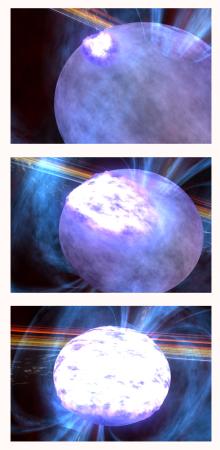
A theory about neutron stars first proposed by a theoretical physicist based at the University of California, Santa Barbara (UCSB) has gained the support of a NASA study reported by an international team of scientists in the July 3 issue of the journal Nature.
Lars Bildsten, a UCSB physics professor and permanent member of UCSB's Kavli Institute for Theoretical Physics (KITP), first developed a theory, published in 1998, which explains how neutron stars, the spinning compact remains of an exploded star, can only spin so fast due to the sudden onset of the emission of gravitational waves.
Bildsten will be present at the NASA press conference in Washington, D.C. on Wednesday, July 2, 1 p.m. Eastern Time. At that time the NASA news release on this topic can be viewed online.
The current study, using NASA's Rossi X-ray Timing Explorer, was led by first author Deepto Chakrabarty, of the Massachusetts Institute of Technology, who was a visiting scholar at KITP when he conducted the research for the Nature article written with an international team of experts.
The theory, developed by Bildsten, involves a feedback mechanism in which the emission of gravitational waves limits just how fast a neutron star can rotate. Some neutron stars reside in binaries, two-star systems, and are spun-up by the accumulation of rapidly rotating material from an orbiting companion. Prior to Bildsten's work, it was thought that the limit to the rotation rate was set by the eventual breakup of the star as the centrifugal force ripped it apart. However, Bildsten proposed that the accretion of material would slightly distort neutron star, allowing it to radiate ripples in space-time. These ripples, or gravitational waves, would then
carry away the angular momentum at a rate which matches the constant torque applied by the accreting matter. This would arrest the spin-up and set a "speed limit" on the rotation rate, now shown by Chakrabarty and collaborators to be about 760 revolutions per second.
Though this new result supports Bildsten's hypothesis, the definitive test will only come by the direct detection of the gravitational waves. The first opportunity for such a test is about six years away, when the advanced version of the Laser Interferometer Gravitational Wave Observatory (LIGO) in Hanford, Wash. and Livingston, La. will be "tuned in" to the neutron stars as they emit gravitational waves.
Bildsten joined the faculty of the UCSB Physics Department and became a permanent member of the KITP in July 1999. He has published over 70 articles in scientific journals. In 1999, he was awarded the Helen B. Warner Prize from the American Astronomical Society. In addition to being cited for this work, he was also recognized for his work on nuclear burning on neutron stars and the theory of lithium depletion. During the most recent Decadal Survey of Astronomy and Astrophysics, Bildsten served on two National Research Council (NRC) panels: High Energy Astrophysics from Space, and Theory, Computation and Data Exploration. He was a member of the Executive Committee of the High Energy Astrophysics Division of the American Astronomical Society in 2000 and 2001 and is presently serving on the NRC's Committee on Astronomy and Astrophysics.
The complete web address for the NASA news release is: http://www.gsfc.nasa.gov/topstory/2003/0702pulsarspeed.html.
Related Links
NASA News Release
Lars Bildsten Web Page
Kavli Institute for Theoretical Physics



